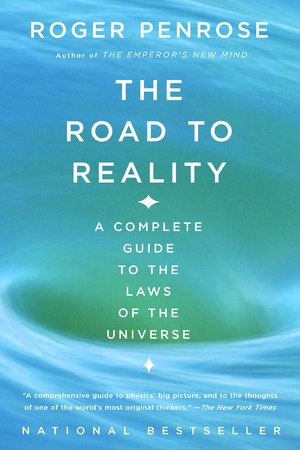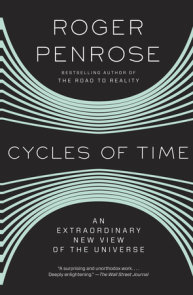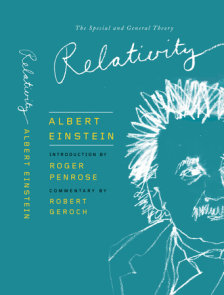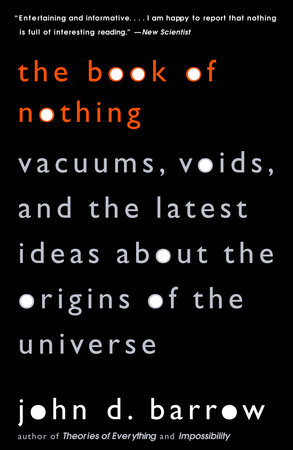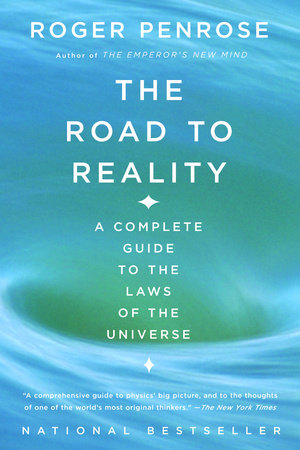

The Road to Reality
By Roger Penrose
By Roger Penrose
By Roger Penrose
By Roger Penrose
Category: Science & Technology
Category: Science & Technology

-
$29.00
Jan 09, 2007 | ISBN 9780679776314
-
Jun 09, 2021 | ISBN 9780593315309
YOU MAY ALSO LIKE
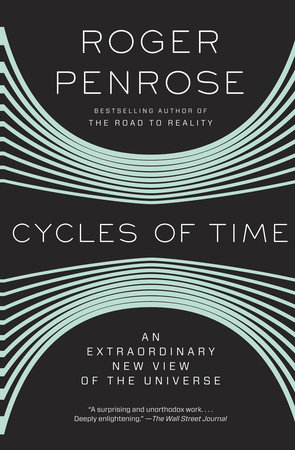
Cycles of Time

Faster Than Light
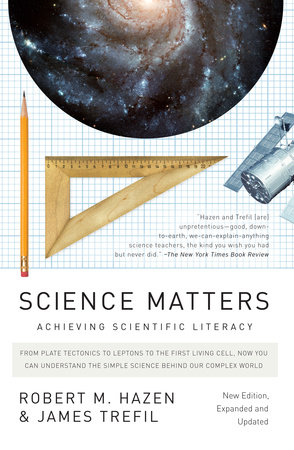
Science Matters
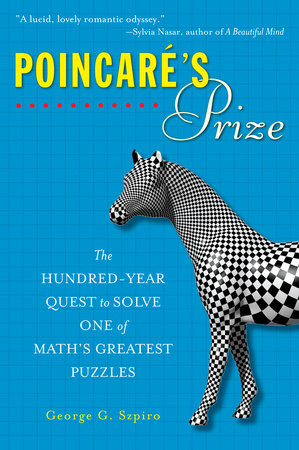
Poincare’s Prize
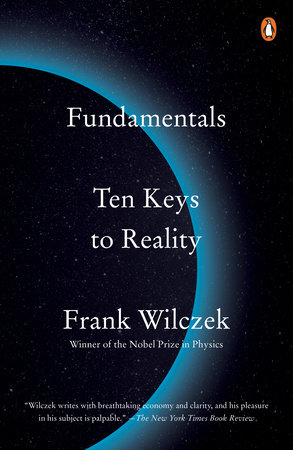
Fundamentals
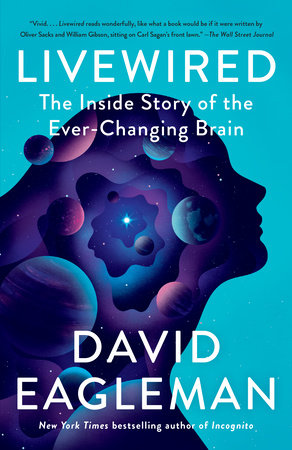
Livewired
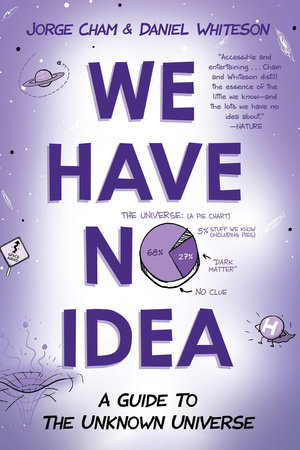
We Have No Idea

The Battle of the Frogs and the Mice
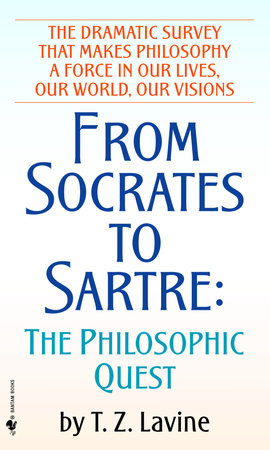
From Socrates to Sartre
Praise
“A comprehensive guide to physics’ big picture, and to the thoughts of one of the world’s most original thinkers.”—The New York Times
“Simply astounding. . . . Gloriously variegated. . . . Pure delight. . . . It is shocking that so much can be explained so well. . . . Penrose gives us something that has been missing from the public discourse on science lately–a reason to live, something to look forward to.” —American Scientist
“A remarkable book . . . teeming with delights.” —Nature
“This is his magnum opus, the culmination of an already stellar career and a comprehensive summary of the current state of physics and cosmology. It should be read by anyone entering the field and referenced by everyone working in it.” —The New York Sun
“Extremely comprehensive. . . . The Road to Reality unscores the fact that Penrose is one of the world’s most original thinkers.” —Tucson Citizen
“What a joy it is to read a book that doesn’t simplify, doesn’t dodge the difficult questions, and doesn’t always pretend to have answers. . . . Penrose’s appetite is heroic, his knowledge encyclopedic, his modesty a reminder that not all physicists claim to be able to explain the world in 250 pages.”
—The Times (London)
“For physics fans, the high point of the year will undoubtedly be The Road to Reality.”
—The Guardian
“A truly remarkable book…Penrose does much to reveal the beauty and subtlety that connects nature and the human imagination, demonstrating that the quest to understand the reality of our physical world, and the extent and limits of our mental capacities, is an awesome, never-ending journey rather than a one-way cul-de-sac.”—London Sunday Times
“Penrose’s work is genuinely magnificent, and the most stimulating book I have read in a long time.”—Scotland on Sunday
“Science needs more people like Penrose, willing and able to point out the flaws in fashionable models from a position of authority and to signpost alternative roads to follow.”—The Independent
Table Of Contents
Preface
Acknowledgements
Notation
Prologue
1 The roots of science
1.1 The quest for the forces that shape the world
1.2 Mathematical truth
1.3 Is Plato’s mathematical world ‘real’?
1.4 Three worlds and three deep mysteries
1.5 The Good, the True, and the Beautiful
2 An ancient theorem and a modern question
2.1 The Pythagorean theorem
2.2 Euclid’s postulates
2.3 Similar-areas proof of the Pythagorean theorem
2.4 Hyperbolic geometry: conformal picture
2.5 Other representations of hyperbolic geometry
2.6 Historical aspects of hyperbolic geometry
2.7 Relation to physical space
3 Kinds of number in the physical world
3.1 A Pythagorean catastrophe?
3.2 The real-number system
3.3 Real numbers in the physical world
3.4 Do natural numbers need the physical world?
3.5 Discrete numbers in the physical world
4 Magical complex numbers
4.1 The magic number ‘i’
4.2 Solving equations with complex numbers
4.3 Convergence of power series
4.4 Caspar Wessel’s complex plane
4.5 How to construct the Mandelbrot set
5 Geometry of logarithms, powers, and roots
5.1 Geometry of complex algebra
5.2 The idea of the complex logarithm
5.3 Multiple valuedness, natural logarithms
5.4 Complex powers
5.5 Some relations to modern particle physics
6 Real-number calculus
6.1 What makes an honest function?
6.2 Slopes of functions
6.3 Higher derivatives; C1-smooth functions
6.4 The ‘Eulerian’ notion of a function?
6.5 The rules of differentiation
6.6 Integration
7 Complex-number calculus
7.1 Complex smoothness; holomorphic functions
7.2 Contour integration
7.3 Power series from complex smoothness
7.4 Analytic continuation
8 Riemann surfaces and complex mappings
8.1 The idea of a Riemann surface
8.2 Conformal mappings
8.3 The Riemann sphere
8.4 The genus of a compact Riemann surface
8.5 The Riemann mapping theorem
9 Fourier decomposition and hyperfunctions
9.1 Fourier series
9.2 Functions on a circle
9.3 Frequency splitting on the Riemann sphere
9.4 The Fourier transform
9.5 Frequency splitting from the Fourier transform
9.6 What kind of function is appropriate?
9.7 Hyperfunctions
10 Surfaces
10.1 Complex dimensions and real dimensions
10.2 Smoothness, partial derivatives
10.3 Vector Fields and 1-forms
10.4 Components, scalar products
10.5 The Cauchy–Riemann equations
11 Hypercomplex numbers
11.1 The algebra of quaternions
11.2 The physical role of quaternions?
11.3 Geometry of quaternions
11.4 How to compose rotations
11.5 Clifford algebras
11.6 Grassmann algebras
12 Manifolds of n dimensions
12.1 Why study higher-dimensional manifolds?
12.2 Manifolds and coordinate patches
12.3 Scalars, vectors, and covectors
12.4 Grassmann products
12.5 Integrals of forms
12.6 Exterior derivative
12.7 Volume element; summation convention
12.8 Tensors; abstract-index and diagrammatic notation
12.9 Complex manifolds
13 Symmetry groups
13.1 Groups of transformations
13.2 Subgroups and simple groups
13.3 Linear transformations and matrices
13.4 Determinants and traces
13.5 Eigenvalues and eigenvectors
13.6 Representation theory and Lie algebras
13.7 Tensor representation spaces; reducibility
13.8 Orthogonal groups
13.9 Unitary groups
13.10 Symplectic groups
14 Calculus on manifolds
14.1 Differentiation on a manifold?
14.2 Parallel transport
14.3 Covariant derivative
14.4 Curvature and torsion
14.5 Geodesics, parallelograms, and curvature
14.6 Lie derivative
14.7 What a metric can do for you
14.8 Symplectic manifolds
15 Fibre bundles and gauge connections
15.1 Some physical motivations for fibre bundles
15.2 The mathematical idea of a bundle
15.3 Cross-sections of bundles
15.4 The Clifford bundle
15.5 Complex vector bundles, (co)tangent bundles
15.6 Projective spaces
15.7 Non-triviality in a bundle connection
15.8 Bundle curvature
16 The ladder of infinity
16.1 Finite fields
16.2 A Wnite or inWnite geometry for physics?
16.3 Different sizes of infinity
16.4 Cantor’s diagonal slash
16.5 Puzzles in the foundations of mathematics
16.6 Turing machines and Gödel’s theorem
16.7 Sizes of infinity in physics
17 Spacetime
17.1 The spacetime of Aristotelian physics
17.2 Spacetime for Galilean relativity
17.3 Newtonian dynamics in spacetime terms
17.4 The principle of equivalence
17.5 Cartan’s ‘Newtonian spacetime’
17.6 The fixed finite speed of light
17.7 Light cones
17.8 The abandonment of absolute time
17.9 The spacetime for Einstein’s general relativity
18 Minkowskian geometry
18.1 Euclidean and Minkowskian 4-space
18.2 The symmetry groups of Minkowski space
18.3 Lorentzian orthogonality; the ‘clock paradox’
18.4 Hyperbolic geometry in Minkowski space
18.5 The celestial sphere as a Riemann sphere
18.6 Newtonian energy and (angular) momentum
18.7 Relativistic energy and (angular) momentum
19 The classical Welds of Maxwell and Einstein
19.1 Evolution away from Newtonian dynamics
19.2 Maxwell’s electromagnetic theory
19.3 Conservation and flux laws in Maxwell theory
19.4 The Maxwell Weld as gauge curvature
19.5 The energy–momentum tensor
19.6 Einstein’s field equation
19.7 Further issues: cosmological constant; Weyl tensor
19.8 Gravitational field energy
20 Lagrangians and Hamiltonians
20.1 The magical Lagrangian formalism
20.2 The more symmetrical Hamiltonian picture
20.3 Small oscillations
20.4 Hamiltonian dynamics as symplectic geometry
20.5 Lagrangian treatment of fields
20.6 How Lagrangians drive modern theory
21 The quantum particle
21.1 Non-commuting variables
21.2 Quantum Hamiltonians
21.3 Schrödinger’s equation
21.4 Quantum theory’s experimental background
21.5 Understanding wave–particle duality
21.6 What is quantum ‘reality’?
21.7 The ‘holistic’ nature of a wavefunction
21.8 The mysterious ‘quantum jumps’
21.9 Probability distribution in a wavefunction
21.10 Position states
21.11 Momentum-space description
22 Quantum algebra, geometry, and spin
22.1 The quantum procedures U and R
22.2 The linearity of U and its problems for R
22.3 Unitary structure, Hilbert space, Dirac notation
22.4 Unitary evolution: Schrödinger and Heisenberg
22.5 Quantum ‘observables’
22.6 YES/NO measurements; projectors
22.7 Null measurements; helicity
22.8 Spin and spinors
22.9 The Riemann sphere of two-state systems
22.10 Higher spin: Majorana picture
22.11 Spherical harmonics
22.12 Relativistic quantum angular momentum
22.13 The general isolated quantum object
23 The entangled quantum world
23.1 Quantum mechanics of many-particle systems
23.2 Hugeness of many-particle state space
23.3 Quantum entanglement; Bell inequalities
23.4 Bohm-type EPR experiments
23.5 Hardy’s EPR example: almost probability-free
23.6 Two mysteries of quantum entanglement
23.7 Bosons and fermions
23.8 The quantum states of bosons and fermions
23.9 Quantum teleportation
23.10 Quanglement
24 Dirac’s electron and antiparticles
24.1 Tension between quantum theory and relativity
24.2 Why do antiparticles imply quantum fields?
24.3 Energy positivity in quantum mechanics
24.4 Diffculties with the relativistic energy formula
24.5 The non-invariance of d/dt
24.6 Clifford–Dirac square root of wave operator
24.7 The Dirac equation
24.8 Dirac’s route to the positron
25 The standard model of particle physics
25.1 The origins of modern particle physics
25.2 The zigzag picture of the electron
25.3 Electroweak interactions; reflection asymmetry
25.4 Charge conjugation, parity, and time reversal
25.5 The electroweak symmetry group
25.6 Strongly interacting particles
25.7 ‘Coloured quarks’
25.8 Beyond the standard model?
26 Quantum field theory
26.1 Fundamental status of QFT in modern theory
26.2 Creation and annihilation operators
26.3 Infinite-dimensional algebras
26.4 Antiparticles in QFT
26.5 Alternative vacua
26.6 Interactions: Lagrangians and path integrals
26.7 Divergent path integrals: Feynman’s response
26.8 Constructing Feynman graphs; the S-matrix
26.9 Renormalization
26.10 Feynman graphs from Lagrangians
26.11 Feynman graphs and the choice of vacuum
27 The Big Bang and its thermodynamic legacy
27.1 Time symmetry in dynamical evolution
27.2 Submicroscopic ingredients
27.3 Entropy
27.4 The robustness of the entropy concept
27.5 Derivation of the second law—or not?
27.6 Is the whole universe an ‘isolated system’?
27.7 The role of the Big Bang
27.8 Black holes
27.9 Event horizons and spacetime singularities
27.10 Black-hole entropy
27.11 Cosmology
27.12 Conformal diagrams
27.13 Our extraordinarily special Big Bang
28 Speculative theories of the early universe
28.1 Early-universe spontaneous symmetry breaking
28.2 Cosmic topological defects
28.3 Problems for early-universe symmetry breaking
28.4 Inflationary cosmology
28.5 Are the motivations for inflation valid?
28.6 The anthropic principle
28.7 The Big Bang’s special nature: an anthropic key?
28.8 The Weyl curvature hypothesis
28.9 The Hartle–Hawking ‘no-boundary’ proposal
28.10 Cosmological parameters: observational status?
29 The measurement paradox
29.1 The conventional ontologies of quantum theory
29.2 Unconventional ontologies for quantum theory
29.3 The density matrix
29.4 Density matrices for spin 1/2: the Bloch sphere
29.5 The density matrix in EPR situations
29.6 FAPP philosophy of environmental decoherence
29.7 Schrödinger’s cat with ‘Copenhagen’ ontology
29.8 Can other conventional ontologies resolve the ‘cat’?
29.9 Which unconventional ontologies may help?
30 Gravity’s role in quantum state reduction
30.1 Is today’s quantum theory here to stay?
30.2 Clues from cosmological time asymmetry
30.3 Time-asymmetry in quantum state reduction
30.4 Hawking’s black-hole temperature
30.5 Black-hole temperature from complex periodicity
30.6 Killing vectors, energy flow—and time travel!
30.7 Energy outflow from negative-energy orbits
30.8 Hawking explosions
30.9 A more radical perspective
30.10 Schrödinger’s lump
30.11 Fundamental conflict with Einstein’s principles
30.12 Preferred Schrödinger–Newton states?
30.13 FELIX and related proposals
30.14 Origin of fluctuations in the early universe
31 Supersymmetry, supra-dimensionality, and strings
31.1 Unexplained parameters
31.2 Supersymmetry
31.3 The algebra and geometry of supersymmetry
31.4 Higher-dimensional spacetime
31.5 The original hadronic string theory
31.6 Towards a string theory of the world
31.7 String motivation for extra spacetime dimensions
31.8 String theory as quantum gravity?
31.9 String dynamics
31.10 Why don’t we see the extra space dimensions?
31.11 Should we accept the quantum-stability argument?
31.12 Classical instability of extra dimensions
31.13 Is string QFT finite?
31.14 The magical Calabi–Yau spaces; M-theory
31.15 Strings and black-hole entropy
31.16 The ‘holographic principle’
31.17 The D-brane perspective
31.18 The physical status of string theory?
32 Einstein’s narrower path; loop variables
32.1 Canonical quantum gravity
32.2 The chiral input to Ashtekar’s variables
32.3 The form of Ashtekar’s variable
32.4 Loop variables
32.5 The mathematics of knots and links
32.6 Spin networks
32.7 Status of loop quantum gravity?
33 More radical perspectives; twistor theory
33.1 Theories where geometry has discrete elements
33.2 Twistors as light rays
33.3 Conformal group; compactified Minkowski space
33.4 Twistors as higher-dimensional spinors
33.5 Basic twistor geometry and coordinates
33.6 Geometry of twistors as spinning massless particles
33.7 Twistor quantum theory
33.8 Twistor description of massless fields
33.9 Twistor sheaf cohomology
33.10 Twistors and positive/negative frequency splitting
33.11 The non-linear graviton
33.12 Twistors and general relativity
33.13 Towards a twistor theory of particle physics
33.14 The future of twistor theory?
34 Where lies the road to reality?
34.1 Great theories of 20th century physics—and beyond?
34.2 Mathematically driven fundamental physics
34.3 The role of fashion in physical theory
34.4 Can a wrong theory be experimentally refuted?
34.5 Whence may we expect our next physical revolution?
34.6 What is reality?
34.7 The roles of mentality in physical theory
34.8 Our long mathematical road to reality
34.9 Beauty and miracles
34.10 Deep questions answered, deeper questions posed
Epilogue
Bibliography
Index
Contents
21 Books You’ve Been Meaning to Read
Just for joining you’ll get personalized recommendations on your dashboard daily and features only for members.
Find Out More Join Now Sign In






